Tea Accessories
Tea Accessories
Browse our collection of antique silver Tea Caddy Spoons, Teapot Stands, Tea Strainers, Spoon Trays etc. After tea was first introduced into England in the late 17th century women adopted the drink for their social gatherings and served tea after dinner. It was also an occasion to demonstrate wealth and good taste by showing off their complement of silver teawares. “Afternoon tea” in Great Britain was established by the seventh Duchess of Bedford in the 19th century. At that time, lunch was taken early and supper very late so the duchess made a habit of taking tea in the afternoon between three and four o’clock together with a light meal. Nowadays, the popular English tea tradition can still be enjoyed with an enchanting array of antique sterling silver accessories.
Tea Caddy Spoons, for measuring out tea leaves, were made from 1780 onwards. Many can be found in novelty shapes such as the collectible jockey cap.
Teapot Stands. Many flat based teapots were found to scorch the tea table so separate teapot stands were made in order to avoid this.
Tea Strainers became popular in the 20th century and are used to filter tea leaves when pouring tea. During the 18th century orange and lemon strainers were popular accessories for punch and they have become popular recently as tea strainers, although they are generally larger than the ones made nowadays.
The Tea Infuser is a device in which loose, dried tea leaves are placed for steeping or brewing, in a cup or teapot full of hot water; it is often called a teaball or tea maker, and sometimes a tea egg.
Spoon trays. Tea drinking became fashionable during the first half of the 18th century and part of the hostess’s tea silver would have been a spoon tray. On this would have been placed a teaspoon and a mote spoon (for straining tea leaves). These spoons were made by specialist flatware makers and are never found with these trays.
Toast racks are not known until the late 18th century. Prior to this toast must have been served on a dish or maybe wrapped in a napkin. Some of the earliest designs have oval or oblong tray bases.
-

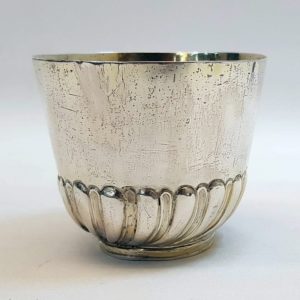
1689
10125 William & Mary Antique Silver Cup
Sold
A rare antique silver cup of tapering form on a small applied foot; the curved flutes on the lower body were a popular decoration from the reign of William & Mary through to Queen Anne. This cup never had a handle and was probably intended for drinking tea or coffee. There are faint traces of the original gilding. Contains 150 ml. Weight 108 grams, 2.1 troy ounces. Height 6.5cm. Diameter of top 7.5cm. London 1689. Maker “OG” – see Jacksons page 129.
-

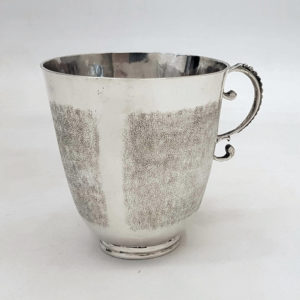
1697
9990 William III Antique Silver Cup
Sold
A very unusual antique silver chocolate cup of tapering form on a small applied foot; the simple “S” scroll handle having a beaded rat-tail decoration. The body has four panels of hand applied matting work. This rare little cup was made for drinking hot chocolate, the newly discovered drinking beverage popular c.1680-1720 – see the coloured illustration. Contains 155ml. Weight 108 grams, 3.4 troy ounces. Height 7.7cm. Diameter of top 7.2cm. Spread across the handle 9cm. London 1697. Maker unknown.
-

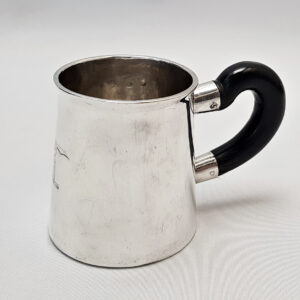
1699 - 1702
Thomas Parr
10415 William III Antique Silver Chocolate Cup
Sold
A charming little collector’s item. This antique silver mug dates from the early 1700’s and has a plain form with straight tapering sides. The dark wooden side handle indicates that the cup was intended for a hot beverage such as chocolate, a fashionable drink at this time. Made of unusually heavy gauge, hand beaten silver, the mug is very sturdy and usable. Hand engraved to the front is a family crest. Contains 290ml. Weight 179g, 5.75 troy oz. Height 8cm. Diameter 6.6cm (top), 7.3cm (base). London 1698/1702. Maker Thomas Parr I. Britannia standard silver, high purity 95.8%. Scratchweight 5=14.
-

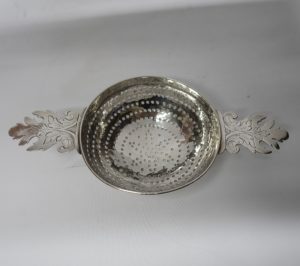
Circa 1710
John Chartier
9020 Queen Anne Antique Silver Lemon Strainer
Sold
A rare early English antique silver strainer of circular form with a turned over rim. *Britannia standard silver. The bowl has drilled pierced holes with a five-pointed star to the centre. The acanthus shaped handles have hand decoration. Weight 68 grams, 2.1 troy oz. Spread 18.5 cm, 7.5 inches. Marked to the reverse of handles with the Britannia standard mark for John Chartier and second makers mark, F R or IB in a shaped cartouche with two pellets above. London circa 1710-15.
-

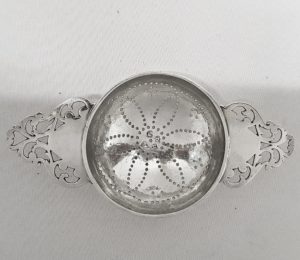
1717
Robert Kempton
9438 Antique George I Silver Lemon Strainer
Sold
A rare early English antique sterling silver strainer of circular form with a turned over rim. The bowl has drilled pierced holes in a flower shape and long shaped handles with pierced decoration. Weight 79 grams, 2.5 troy oz. Spread 16.6cm. Diameter 8.5cms. Height 3cm. London 1717. Maker Robert Kempton.
-

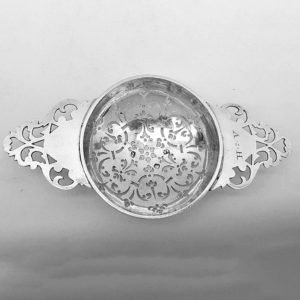
1722
John Albright
9942 George I Antique Silver Strainer
Sold
A rare early English antique sterling silver strainer of circular form with decorative side handles. A very charming and useful size; although originally made as a lemon strainer this could be used nowadays as a tea strainer. The bowl is pierced with a design of scrolls and other motifs and contemporary owner’s initials are engraved to one handle. Weight 75 grams, 2.4 troy oz. Spread 16.8cm. Diameter 8.5cm. Height 2.9cm. London 1722. Maker John Albright. Sterling silver
-

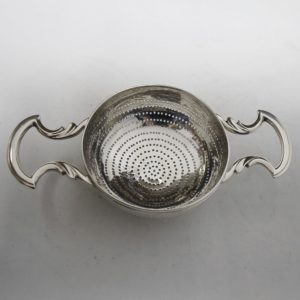
Circa 1750
9093 Antique Georgian Silver Lemon Strainer
Sold
A rare early English antique sterling silver strainer of circular form with a turned over rim. The bowl has drilled pierced holes in concentric circles and long shaped handles with leaf decoration. To the front there is a hand engraved initial. Weight 98 grams, 3.1 troy oz. Spread 16.5 cm. Diameter 8.5 cms. Height 3.3 cms. Marks indistinct. English. Circa 1750.
-

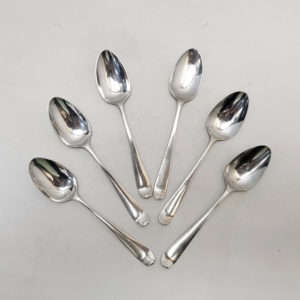
1785
Hester Bateman
10280 George III Antique Silver Teaspoons
Sold
A good set of 6 antique sterling silver spoons, in the Hanoverian pattern, by the sought after lady silversmith Hester Bateman. Total weight 59 grams, just under 2 troy ounces. Length 11.5cm. London 1785. Sterling silver. 18th century.
-

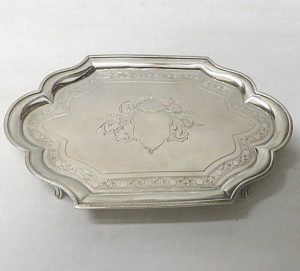
1796
Peter & Ann Bateman
7582 Georgian Silver Teapot Stand
Sold
An attractive antique silver salver of serpentine form raised on four splay feet. Plain design with bright cut engraved borders and decorative hand engraved central cartouche (uninscribed). This quality engraving is to be expected from this family of sought after silversmiths. Weight 151 grams, 4.8 troy ounces. Length 19.5 cms. Width 13 cms. London 1796. Maker Peter and Ann Bateman.
-

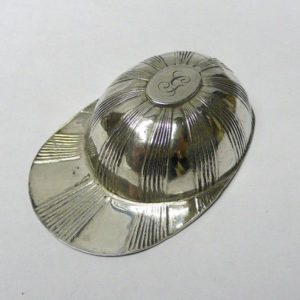
1798
Samuel Pemberton
8663 Antique Silver Jockey Cap Caddy Spoon
Sold
A rare and collectable early silver caddy spoon in the form of a jockey cap. It has a ribbed design and a plain centre button with the initial “G” in old fashioned script. Weight 8 grams. Measures 5.5 x 3.8 cms. Birmingham 1798. No maker’s mark* but almost certainly made in Birmingham by Samuel Pemberton. For a similar example see ‘Caddy Spoons, an Illustrated Guide’ by John Norrie, plate 95c.
-


Circa 1800
7511 Antique Dutch Silver Caddy Spoon
Sold
A rare antique silver caddy spoon in the form of a fish with the tail prettily engraved with bright cutting. Lovely graceful lines. Weight 7 grams. Length 8 cms. With Dutch silver stamps. Circa 1800.
-

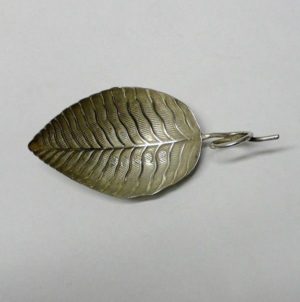
1801
Joseph Taylor
8671 Georgian Silver Caddy Spoon
Sold
A rare antique sterling silver caddy spoon in the form of a leaf with a curled handle. Weight 7 grams. Length 7.5 cms. Width 3.25 cms. Birmingham 1801. Maker Joseph Taylor.
-

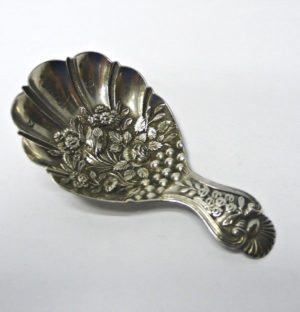
1822
Joseph Willmore
8249 Antique Silver Caddy Spoon
Sold
A pretty little Victorian sterling silver caddy spoon with a shell shaped bowl and shaped shell handle. With a very pretty embossed flower design to the bowl. Weight 11 grams. Length 7.7 cms. Width 4.2 cms. Birmingham 1822. Maker Joseph Willmore.
-

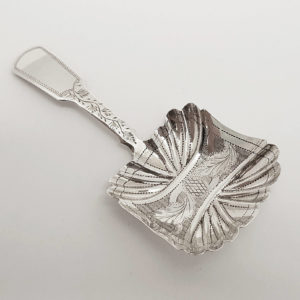
1836
9547 Antique Silver Caddy Spoon
Sold
A pretty little antique silver caddy spoon with a square fluted bowl and shaped handle. Pretty bright cut engraved decoration. Weight 7 grams. Length 8 cms. Birmingham 1887. Maker James Collins.
-

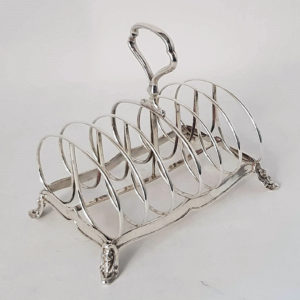
1845
Joseph Angell
9814 Victorian Silver Toast Rack
Sold
A well modelled antique silver toastrack of classic design with a shaped handle and face mask decorated feet. Good size and weight. 6 slices. Weight 275 grams, 8.8 troy ounces. Height 15cm. Length 17cm. Width 11.2cm. London 1845. Maker Joseph Angell. Sterling silver.
-

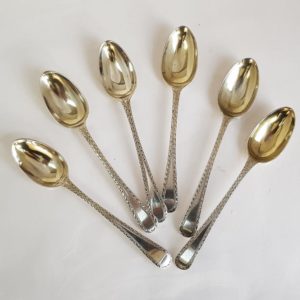
Circa 1882
Henry John And James Wakely
8633 Antique Silver Tea Spoons
Sold
A good matched set of 6 antique sterling silver spoons in the attractive feather edge pattern. Gilt bowls. Total weight 96 grams, 3 troy ounces. Average length 12.6 cms. 3 spoons London 1882, maker Henry John Lias & James Wakely. The other 3 spoons have the lion mark only, minor difference in size.
-

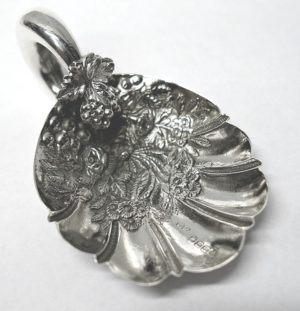
1888
George Unite
8811 Antique Silver Caddy Spoon
Sold
A delightful little Victorian sterling silver caddy spoon having a shell shaped bowl and ring handle. With a very pretty embossed flower design to the bowl. Weight 11 grams. Length 7 cms. Width 4.3 cms. Birmingham 1888. Maker George Unite.
-

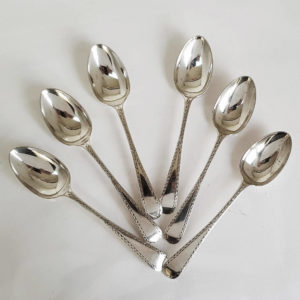
1906
Cooper Brothers
8632 Antique Silver Tea Spoons
Sold
A good set of 6 antique sterling silver spoons in the attractive feather edge pattern. Total weight 104 grams, 3.3 troy ounces. Length 12.6 cms. Sheffield 1906. Maker Cooper Brothers & Sons Ltd.
-

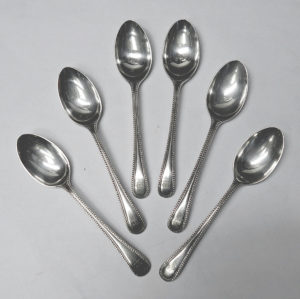
1909
Henry Atkin
8929 Antique Silver Coffee Spoons
Sold
A set of 6 sterling silver spoons in the popular bead pattern. Each has hand engraved initials in old fashioned script. Total weight 89 grams, 2.8 troy ounces. Length 11 cms. Sheffield 1909. Maker Henry Atkins.
-

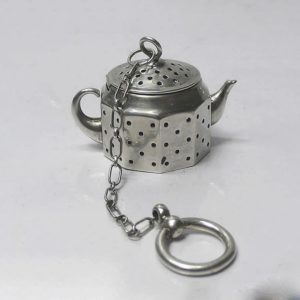
Circa 1930
6340 Vintage Silver Tea Infuser
Sold
A charming little sterling silver tea infuser in the shape of a teapot. Ideal for making a single cup of tea without a teapot – just put tea leaves inside and immerse in a cup of boiling water to make a perfect brew! Weight 22 grams. Height 3.25 cms. Base diameter 3 cms. Stamped underneath “sterling”. Circa 1930. American.
Recently Viewed Products
-

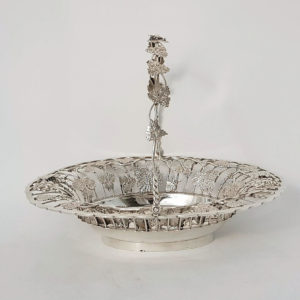
1903
William Comyns
9813 Antique Silver Basket
An excellent antique silver swing handle basket with wirework body. Charming period style. The applied vine leaf decoration is highlighted with bunches of grapes and little bees. Weight 446 grams, 14.3 troy ounces. Length 25.5cm. Width 21.5cm. Height 5.9cm (without handle). London 1903. Maker William Comyns. Sterling silver.
-

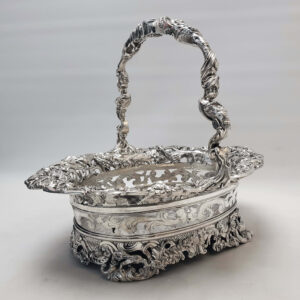
1808
John Clarke II
10336 George III Antique Silver Basket
A large rococo revival cake basket in the style of Paul de Lamerie and combining the flamboyant features typical of the Regency period. Very heavy weight. The quality of the workmanship is exceptional, with elaborate piercing and hand chased mythical beasts, flower scrolls and trellis work. The cast fixed handle is supported by bold female figure head models. The centre is expansively engraved with a coat of arms to the centre, possibly for the Lloyd family. Weight 3631g, 116.7 troy oz. Height 31cm. Top measures 36.5 x 29.5cm. London 1808. Maker’s mark IC probably for John Clarke II. Sterling silver.
-

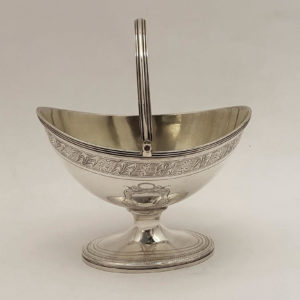
1796
Henry Chawner And John Emes
7063 George III Sugar Basket
Sold
A classic design antique sterling silver bonbon basket with swing handle and pedestal foot. Very attractive oval boat shape. Pretty bright cut engraving to the body and foot and there is a decorative cartouche to the front and back (uninscribed). Original gilt interior. Weight 192 grams, 6.1 troy ounces. Height 9.5 cms (15 cms to top of handle). Length 12.75 cms. Width 8.5 cms. London 1796. Maker Henry Chawner and John Emes.
-

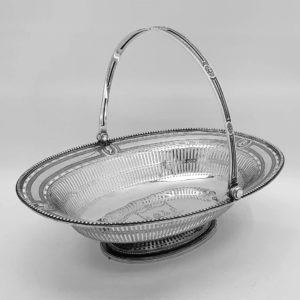
Circa 1780
9862 Georgian Silver Basket
A superb antique silver swing handle basket with pierced work silver body and bead borders. Lovely classical style with bands of matting and Roman emperor face masks. In the centre there are hand engraved crests of a stag and unicorn within a decorative cartouche. Weight 1143 grams, 36.7 troy ounces. Length 37cm. Width 28cm. Height 10.3cm, 27cm (to top of handle). Unmarked silver. Circa 1780. English sterling silver.